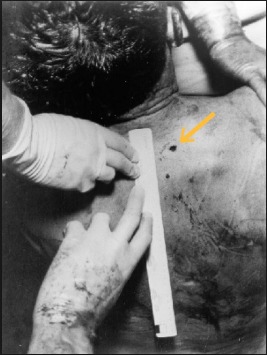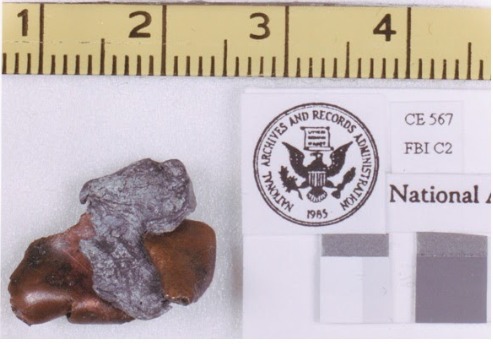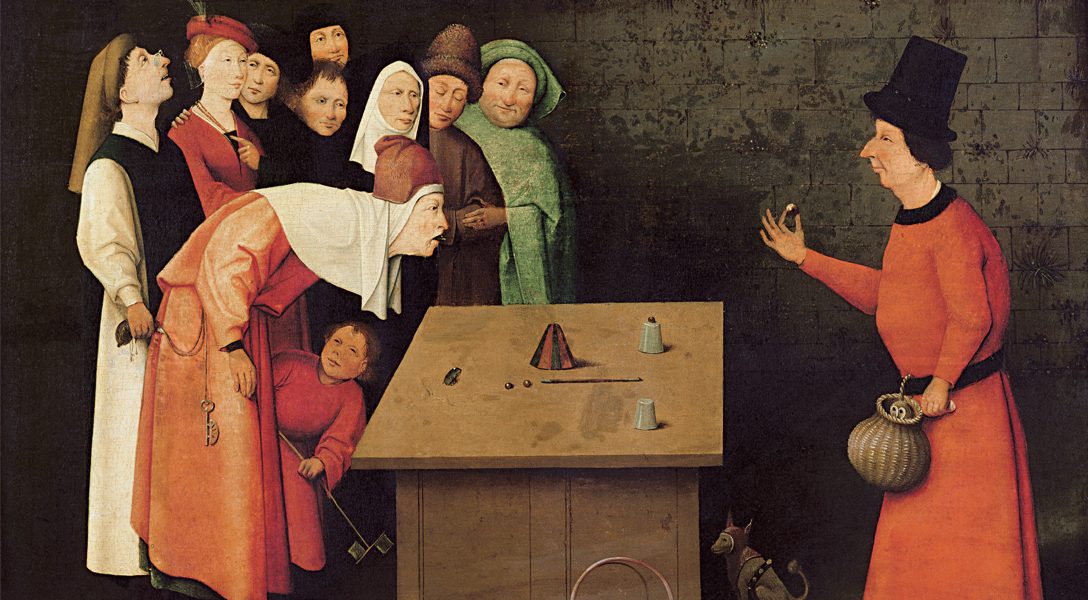A report about some amazingly simple chicanery buried under dense clouds of calculations secreted by a scientist determined to prove President John F. Kennedy was shot only from behind.
Should we trust “experts” writing in “peer reviewed” journals who seek to promote interpretations of events preferred by the very establishment whose approval is necessary for their career advancement? Is this about National Security — the usual reason given when it comes to hiding the truth in the Kennedy assassination — or is it about job security? Ambition?
Are we being cynical to wonder about these things? See if the following revelations make you wonder as well. In any case, if you like puzzles, you should find this report engaging. Or, if you’re not in the mood for much reading, you can skip the report and look at the pictures.
‘Back and to the Left’
.
That’s what traumatized viewers saw in the Zapruder film as President John F. Kennedy’s body reacted to a bullet to the head. But what did that movement — seared into all of our minds via television, Oliver Stone’s JFK, and YouTube — actually prove?
That is one of the great mysteries of one of the greatest continuing debates of all time. And it leads to bigger questions: Who killed Kennedy, and why?
To those who support the lone gunman theory, the shot came from behind — the supposed lair of Lee Harvey Oswald. But Kennedy was knocked backward, suggesting he was hit from the front. Which would mean Oswald did not fire that bullet.
This image — combined with the discrepancies in the government’s reporting of the most fundamental facts in the case — perpetuate the well-earned distrust of official sources. (For details on discrepancies in the medical-ballistic evidence, please go here, here, here, here, here, here, here, and here.)
Lone-gunman theory advocates have sought to explain away this anomaly, utilizing a long string of purported experts. The establishment media, showing little interest in exploring other possibilities, has long promoted these counterintuitive explanations.
The latest comes from Nicholas R. Nalli, a PhD in atmospheric and oceanic sciences and senior research scientist with I.M. Systems Group, Inc. at STAR. He performs research at the National Oceanic and Atmospheric Administration (NOAA) and is said to have expertise in geophysics, optics, and remote sensing.
According to his biography, “He is also interested and active in science education and public outreach.” His article on the assassination may be considered public outreach — but it should not be considered “science education.” It is more political than scientific.
Nalli’s article is insidiously misleading, and full of intellectual sinkholes hidden beneath an impressive surface of scientific arcana.
Titled “Gunshot-Wound Dynamics Model for John F. Kennedy Assassination,” it was published in Heliyon, an “open access journal,” and has been getting a lot of attention. It has been promoted in Daily Mail, Newsweek, history.com, Komsomolskaya Pravda, and several other places. According to a press release from Heliyon’s parent company, Elsevier,
The Zapruder film shows the President’s head moving back and to the left, which Dr. Nalli soon realized was due to a recoil effect…
He developed a simple one-dimensional gunshot wound dynamics model to explain the movements observed in the film… This is the first time this aspect of the case has been considered so thoroughly and quantitatively.
In the following report, I focus only on the “recoil effect” (also called the “jet effect”), as presented by Nalli, and by his source of inspiration, Luis Alvarez. I also examine the sources he uses to verify it, in particular, John Lattimer. I leave to others the evaluation of Nalli’s comments on neurospasm.
A Conjuring Act: Don’t Blink
.
Nalli embraces the theories of Nobel prize-winning physicist Luis Alvarez who — with the sponsorship of the Department of Energy — designed experiments to “prove” Kennedy’s exploding brain sent his head backward (American Journal of Physics 1976; 44:813-827). Alvarez called it “jet effect.”
Nalli writes that he himself will examine this effect in “considerably more detail.” Before looking at these details, you should first understand something Nalli does not tell you — Alvarez’s work has a fatal flaw. The first amazing hint of it is right in Alvarez’s introduction:
Most of the critics … treat the problem as though it involved only two interacting masses: the bullet and the head. My analysis involves three interacting masses, the bullet, the jet of brain matter observable in frame 313 [Zapruder film], and the remaining part of the head. It will turn out that the jet can carry forward more momentum than was brought in by the bullet, and the head recoils backward, as a rocket recoils when its jet fuel is ejected.
Let’s take a good look at these “three interacting masses” in slow motion:
Bullet enters brain… brain explodes… jet of brain matter propels “remaining” head backward.
But what about the first interaction? The one that occurs before the bullet even gets to the brain: the collision between bullet and the back of the head.
This first collision would knock the head in the direction of the bullet — and that forward movement and transfer of energy would compete with any alleged jet effect causing the head to move backward.
And it had to be quite a violent collision. According to the official narrative, a bullet slammed into the back of JFK’s head traveling at nearly 1900 feet per second, broke into two jacketed fragments, leaving behind multiple lead fragments, and a thin round fragment embedded in the skull.
At first, I thought Alvarez had just assumed readers didn’t need to be told about this first collision, but when I looked at his mathematical equations, I was shocked to see that he didn’t represent it there either.
So how did he avoid it in his actual experiments? For skulls, he used a much softer target — melons wrapped in tape, then fired at them at close range, with a much more destructive bullet than the one that allegedly hit Kennedy.
Despite the way Alvarez rigged his experiments, they didn’t even deliver proof of the jet-effect explanation. Dr. Gary Aguilar reported that photographs in Alvarez’s private files, obtained from Paul Hoch, Alvarez’s graduate student assistant, showed that
Virtually all the objects he fired at flew away from the shooter, not toward him, except for the ones he reported in the AJP. [American Journal of Physics]
If jet effect is a viable explanation for what you see on the Zapruder film — why is so much deception needed to sell it?
Nalli may not have been aware of these more recent revelations about the true results of Alvarez’s experiments, but it is hard to believe he did not see something wrong with the fact that Alvarez tried to make that first interaction, the one between bullet and back of head — disappear.
Did Nalli do the same thing in his own way?

Nalli’s Conjuring Act
.
Nalli’s paper begins with the usual pro-government version of the crime, along with the points he wishes to make: that JFK’s head first moved forward a few inches; jet effect moved his head backward; neurospasm moved the rest of his body. His beginning and concluding remarks are all in plain English.
But most of this article consists of dense clouds of calculations. Navigating through them is like wandering through a maze enveloped in haze. For laypersons, including the media, this kind of material is difficult if not impossible to understand. And yet…
Even a layperson can identify a few critical assumptions that cannot be right.
Major Deception on First Collision
.
As mentioned earlier, Alvarez completely skipped over the first interaction, the collision between bullet and back of the head. It just doesn’t exist in his calculations. Nalli, on the other hand, did include it, but he greatly diminished its power — and tried to conceal the fact that he did.
The presented areas of the projectile may be estimated from its diameters at skull entrance and exit. Because the Carcano bullet is extremely stable during normal flight through air, the entrance diameter 0 is simply the cross-sectional diameter of an unfired bullet, which is known to be 0.67 cm [centimeters, i.e., about 7 millimeters].
The first thing you should find suspicious is that Nalli suggests the size of the entrance can be “estimated.” Who needs an estimate when the information is on record? This is an egregious act of deception which leads to a false conclusion.
According to the autopsy report, the entrance wound was 6 x 15 millimeters.
Why does Nalli want you to think the entrance wound was only 0.67 cm — or only 7 millimeters — when the true “presented area” is over twice the size implied by Nalli? The importance of that “presented area” is huge!
It is precisely the collision and drag forces acting upon a projectile that impart an impulse force and acceleration on the target… and these forces are directly proportional to projectile’s presented area… [Emphasis mine.]
And Nalli told me in an email on May 18, 2018,
The amount of energy (and momentum) deposited to the target is dependent upon the amount of deformation (flattening) of the projectile from its entrance to its exit. The amount of deformation of the projectile, while not known exactly, is estimated from the beveled exit wound, which was measured to be 2.5 to 3.0 cm in the Autopsy Report.The greater the deformation, the greater the presented area, the greater the energy deposit, and the greater the spray velocity.
Yes, the greater the presented area, the greater the energy deposit, but Nalli applies this more to the spray velocity of brain tissue — the alleged jet effect in other words.
Again I ask, what about the presented area and energy deposit, to the back of the head?
The elliptical shape of the long entrance wound indicates a sideways or tangential hit (the two are different but have much in common). This would mean the bullet was in contact with the bone in front of it longer than it would have been in a nose-on hit.
And the longer bullet and bone are in contact, the more energy is imparted to the bone — and, in some circumstances, the more the head moves, until the bone in front of it detaches completely. According to Capt. Philip Dodge, tangential strikes can actually knock a person down. (Journal of Neurosurgery 9,1952, 472-483.)
Some believe JFK would have moved more dramatically forward had it not been for a nearly simultaneously fired bullet from the front, knocking him backward. And, because of his back brace and the Ace Bandage wound around his waist, JFK may have been more easily pushed in any direction.
Significance: In his calculations, Nalli greatly diminishes the effect of bullet on bone upon entering. How can this not affect his calculations?
Brain Size Misrepresented
.
One of Nalli’s false assumptions concerns the mass of John Kennedy’s brain. The following has been the cause of much merriment among the knowledgeable and is what publishers call a “howler”:
Although the autopsy reported the brain mass to be 1500 g, this number will be too small due to the loss of tissue, blood and fluid from the gunshot wound. Given the assumed brain loss for the jet spray of 20 ± 10% … the living brain mass before wounding is taken to be 40% more than the autopsy-measured value, thus ≈ 2100 g. From these parameters, the theoretical spray speed is subsequently calculated to be in the range of ≈3200–3500 cm∕s (depending on the assumed exit wound diameter), which are in general agreement with the observed values from the Zapruder Film, thus lending confidence to these estimates…
The average human adult male brain is between 1300 and 1400 grams (sources: here and here). So how could Kennedy’s brain be 1500 grams after being shot? (The 1500-gram figure is not the only anomaly of the autopsy report concerning the brain. The report did not include any description of the cerebellum, which is highly irregular considering this was an autopsy on a man shot in the head. Please go here for more on this bizarre story.)
Based on the assumption that the brain lost about 40 percent of its mass, Nalli added that much “back into” the brain, making its assumed pre-assassination weight 2100 grams! On this figure, he calculated the spray speed? This would seem to give the rocket quite a boost.
This error strongly suggests that no neurologist vetted this paper, despite its promotion of the neurospasm theory as the only explanation for the movement of Kennedy’s torso after jet effect supposedly moved his head. Although additional brain seems to help fuel Nalli’s theory, I doubt that he used this figure knowing it is comically false.
One of Nalli’s Main References: John Lattimer
.
On 13 separate instances, Nalli refers to the work of the late John K. Lattimer, MD, who spent decades using fraudulent means to prove the conclusions of the Warren Commission. His demonstrations of the jet effect and the single bullet theory were so amateurish they would have been scorned as junior high school science projects.
Lattimer reminds me of the kind of cut-rate magician who pulls a rabbit out of the hat without first displaying the “empty” hat.
But all major promoters of the official narrative have depended on his articles for material: authors Gerald Posner and Vincent Bugliosi, for example; producers of numerous TV specials; John McAdams, who runs a website and teaches classes on the assassination at Marquette University; and an assortment of trolls.
Related: Disinformation Part 1: How Trolls Control An Internet Forum
Lattimer was quite a character. The New York Times described him as “a prominent urologist, ballistics expert and collector of historical relics who treated top-ranking Nazis during the Nuremberg war crimes trials.” Among his historical relics were a a glass ampoule that contained the cyanide taken by Hermann Göring, a powder compact with Eva Braun’s initials, President Lincoln’s blood-stained collar, and Napoleon’s penis.
And he “was the first non-governmental medical specialist allowed to examine the evidence in President John F. Kennedy’s assassination.” J. Edgar Hoover was a patient of his and may have had something to do with Lattimer’s involvement in “explaining” the evidence.
You may wonder how a urologist could get published on subjects requiring expertise in neurology and physics. The answer is simple. He submitted them to journals that, unknown to the public, have lenient standards and are not read by specialists with deep knowledge of a subject. And such articles get classified as “Biography” or “Historical Medicine,” which protects them from serious vetting. The mainstream press, assuming the paper has been reviewed by relevant experts, spreads the word.
Luis Alvarez of course had the relevant qualifications, but he published his jet-effect article in one of the less sophisticated physics journals that was read mostly by students.
Both Lattimer and Alvarez wrote in the same manipulative, ingratiating style. Their writing vibrates with buzz words designed to earn your trust. Alvarez included references to Life Magazine… Thanksgiving… Christmas… football… the American flag… his service in World War II… Lattimer’s service in World War II. Somehow, he omitted references to mother, apple pie, the family dog, and church.
Get a Load of This!
.
Before getting into Lattimer’s own jet effect, you may wish to see something more immediately comprehensible. The scam revealed below was designed to solve the big problem concerning the location of Kennedy’s back wound: according to clear photographic evidence, it was too low to comport with the single-bullet theory. A bullet from the sixth floor of the Depository Building (the “sniper’s nest”) would not have been able to enter that low, then go up to exit Kennedy’s throat, which was at a higher level. And if it did not exit the throat, this would have to mean the throat wound was caused by a bullet coming from the front. So Lattimer created a model of a skeleton showing the bullet entering several inches higher than it actually did:

In Lattimer’s model, the bullet enters at the sixth cervical vertebra (C6) — almost at the top of JFK’s shirt collar! Please compare the above contrivance with the photograph below, showing the actual back wound:

Here is that part of the autopsy face sheet that concerns the location of the back wound — and it is in the back, not the neck:

Lattimer Conjures Jet Effect
.
Getting back to what happened to Kennedy’s head, Nalli said Alvarez’s work “has been backed up by subsequent independent experimental studies.” (This is a bit of a non-starter since not even Alvarez backed up Alvarez.) This comment is accompanied by three references, giving the impression of three separate studies. One of them referred to a study which did not backup Nalli’s claims. The other two refer to the same work — John Lattimer’s — reported in two different places. Here is how Alvarez’s conclusions were “backed up” by Lattimer:
False: Large Bone Fragment Sent ‘40 Feet’ in Air
Lattimer said the largest bone fragment “exploded upward and forward due to the power of this destructive bullet and was forced 40 feet in the air by the explosion of the brain.”
Fact: That large fragment, along with two smaller ones, was found in the back of Kennedy’s limousine. Its journey was only in inches, not feet. You can see it on Kennedy’s right shoulder in the famous Moorman Polaroid photo. And, in several frames of the Zapruder film, you can watch as it makes its way down Kennedy’s back. Secret Service Agent Clint Hill, famous for leaping upon the limousine to protect Mrs. Kennedy, saw a large fragment detach from Kennedy’s head.
False: Three Bone Fragments Were Found in the Street
“Three fragments of skull picked up in the street in Dallas account for the majority area of bone that was missing and were clearly the fragments seen leaving the head in a forward and upward direction in frame 313 of the Zapruder move of the shooting.”
Fact: They were found in the limousine. (Another good sized fragment was found on the south lawn.)
False: Mrs. Kennedy Is Thrown Onto Trunk of Car
“Because the exit wound is in the right side, it also drives JFK over towards his left (towards Mrs. Kennedy) where he falls down on the seat. She rises to one knee to let him fall where she had been sitting. Then the car jerks forward and throws her out full length on the car trunk.”
Fact: Secret Service Agent Clint Hill testified to the Warren Commission that Mrs. Kennedy appeared to be reaching for something coming off the the right rear bumper of the car, the right rear tail.” In a recent interview (2017) with MSNBC’s Hallie Jackson, he was more specific. He said she was “trying to grab some of the material that came out of the President’s head.” He also said he was covered in blood and brain.
False: Opening in Skull Was Only on Top, Side
Nalli says JFK’s head was moved to the back and the left because of rapidly exploding brain matter exiting the top right side of his head. And he tells you, “For a thorough description of the head wound, the reader is referred to Lattimer et al.”
Once again, Nalli does not refer you to the autopsy report. Instead, he steers you to Lattimer, who never even saw the wound. Lattimer would never tell you that the occipital bone — which is in the back of the head — was involved. The autopsy report describes the great defect as chiefly on top of the head, but “somewhat” in the occiput. But according to the doctors at Parkland Hospital in Dallas — including the chief neurosurgeon — a great deal of the occiput was involved.
It’s possible that Nalli may not be aware of the discrepancies between what the Dallas doctors observed in the emergency room and what the autopsy doctors in Bethesda, MD, reported — but he doesn’t even give you the official, government-approved (at least in 1964) autopsy information concerning that skull opening.
Here is how Lattimer — and now Nalli — want you to picture Kennedy’s skull opening:

Here is a diagram of how JFK’s skull damage is remembered by J.Thornton Boswell, MD, one of the three pathologists who performed the autopsy:

False: Damage to Experimental Skulls Duplicated Damage to JFK’s
Does this “duplication of JFK’s skull wound” look valid to Nalli? If so, why?

False: Damage to Experimental Bullets Same as JFK’s Head Bullet
Here is a mysterious lie. It may be only a small thing, but then why lie about it? Lattimer said that in all experiments, his and those performed by the Army for the Warren Commission, there was a “complete separation” of the copper shell and the lead core, which is what he claims happened to the bullet that hit JFK in the head.
Fact: The bullet alleged to have hit JFK in the head broke into two fragments — and both were jacketed. Obviously so:


But here is Lattimer’s curiously false presentation:

Neither Lattimer nor the Army reproduced the damage to the assumed Carcano bullet fragments found in the front seat. Could those fragments have come from two different bullets? Or maybe the problem has to do with how much energy the bullet would lose if it broke into two jacketed fragments.
Did Nalli notice any of these discrepancies?
Was Nalli Fooled? Or Is He Doing His Own Fooling?
.
Does Nicholas Nalli know of the vast amount of evidence that should make him skeptical of the government-approved version of Kennedy’s murder?
Does Nalli notice the differences between that government-approved version — and Lattimer’s tarted up version?
Did he even take a good look at Lattimer’s papers? Or did he just assume that surely Lattimer would accurately present the facts as he understood them, so there was no need to study them. Was he encouraged to rely on him by the others?
But how could anyone, on either side — especially a scientist — let others do their thinking for them?
I ask myself these questions as I try to understand how he could possibly allow his good name to be associated with such a person. Has Nalli been conned by Lattimer and others? How could that happen? Here’s an interesting bit of wisdom from a magician that might explain Nalli’s trust in such people:
A magician will instantly see the truth behind any colleague’s illusion. But we have a bit of an advantage: We know we are being fooled. Scientists are instinctive doubters who employ a rigorous method to zero in on the truth, but they aren’t necessarily trained to expect deception by subjects and collaborators.
I would like to think the magician’s insight explains why Nalli trusted people like John Lattimer — but I can’t help but wonder if it really explains why people trust Nalli.
Because there’s one seemingly small fact that I can’t get out of my mind: When it came to that important first collision, Nalli tried to con us the same way Alvarez did. In Nalli’s case, it was all about a few millimeters.
Related front page panorama photo credit: Adapted by WhoWhatWhy from Nicholas Nalli (NOAA) and equations (Heliyon).



